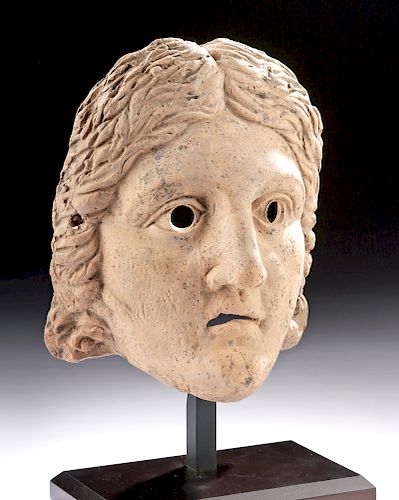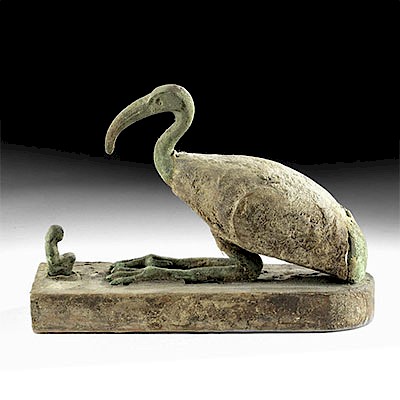Expressive Roman Terracotta Actor's Mask of Female
Lot 71b
About Seller
Artemis Gallery
686 S Taylor Ave, Ste 106
Louisville, CO 80027
United States
Selling antiquities, ancient and ethnographic art online since 1993, Artemis Gallery specializes in Classical Antiquities (Egyptian, Greek, Roman, Near Eastern), Asian, Pre-Columbian, African / Tribal / Oceanographic art. Our extensive inventory includes pottery, stone, metal, wood, glass and textil...Read more
Estimate:
$4,000 - $6,000
Absentee vs Live bid
Two ways to bid:
- Leave a max absentee bid and the platform will bid on your behalf up to your maximum bid during the live auction.
- Bid live during the auction and your bids will be submitted real-time to the auctioneer.
Bid Increments
| Price | Bid Increment |
|---|---|
| $0 | $25 |
| $300 | $50 |
| $1,000 | $100 |
| $2,000 | $250 |
| $5,000 | $500 |
| $10,000 | $1,000 |
| $20,000 | $2,500 |
| $50,000 | $5,000 |
| $100,000 | $10,000 |
| $200,000 | $20,000 |
About Auction
By Artemis Gallery
Oct 31, 2019
Set Reminder
2019-10-31 10:00:00
2019-10-31 10:00:00
America/New_York
Bidsquare
Bidsquare : Fine Antiquities, Asian, Ethnographic Art
https://www.bidsquare.com/auctions/artemis-gallery/fine-antiquities-asian-ethnographic-art-4581
Our Halloween Day auction features classical antiquities, ancient and ethnographic art from cultures encompassing the globe, plus fine art. Artemis Gallery info@artemisgallery.com
Our Halloween Day auction features classical antiquities, ancient and ethnographic art from cultures encompassing the globe, plus fine art. Artemis Gallery info@artemisgallery.com
- Lot Description
Roman, Imperial Period, ca. 1st to 2nd century CE. A stunning actor's mask, skillfully mold-made, depicting a beautiful female visage with openwork eyes, an elegantly arched browline delineated above, a relatively naturalistic nose, a petite open mouth suggesting that the figure is perhaps speaking, chanting, or singing, and finely rendered facial contours with a cleft chin. Theatre masks worn by actors were made of fabric and painted, so that they were light and easy to remove, while terracotta masks like this one were more likely created to be hung on walls, as souvenirs of performances, or as votive dedicatory offerings to Bacchus (Greek Dionysus). Size: 6.125" W x 7.5" H (15.6 cm x 19 cm); 9.75" H (24.8 cm) on included custom stand.
According to scholar Colette Hemingway, "Our interest in the theater connects us intimately with the ancient Greeks and Romans. Nearly every Greek and Roman city of note had an open-air theater, the seats arranged in tiers with a lovely view of the surrounding landscape. Here the Greeks sat and watched the plays first of Aeschylus, Sophokles, Euripides, and Aristophanes, and of Menander and the later playwrights." ("Theater in Ancient Greece" The Met Heilbrunn Timeline of Art History, Metropolitan Museum of Art, October 2004)
This type of terracotta mask was associated with the choruses of Greek drama and was often used as a votive offering dedicated by to shrines and/or graves by individuals who were linked to the theater - either as a known patron, participant, admirer of the arts, or reveler during Dionysiac festivals.
Provenance: private East Coast, USA collection; ex-private Malibu, California, USA collection, 1990's
All items legal to buy/sell under U.S. Statute covering cultural patrimony Code 2600, CHAPTER 14, and are guaranteed to be as described or your money back.
A Certificate of Authenticity will accompany all winning bids.
We ship worldwide and handle all shipping in-house for your convenience.
#149773Repaired from about 5 large pieces with restoration over the break lines. Perforations at top and sides for suspension. Normal surface wear with chips, scuffs, and abrasions commensurate with age. Surface is covered with mineral deposits.Condition
- Shipping Info
-
All shipping is handled in-house for your convenience. Your invoice from Artemis Gallery will include shipping calculation instructions. If in doubt, please inquire BEFORE bidding for estimated shipping costs for individual items.
-
- Buyer's Premium



 EUR
EUR CAD
CAD AUD
AUD GBP
GBP MXN
MXN HKD
HKD CNY
CNY MYR
MYR SEK
SEK SGD
SGD CHF
CHF THB
THB














